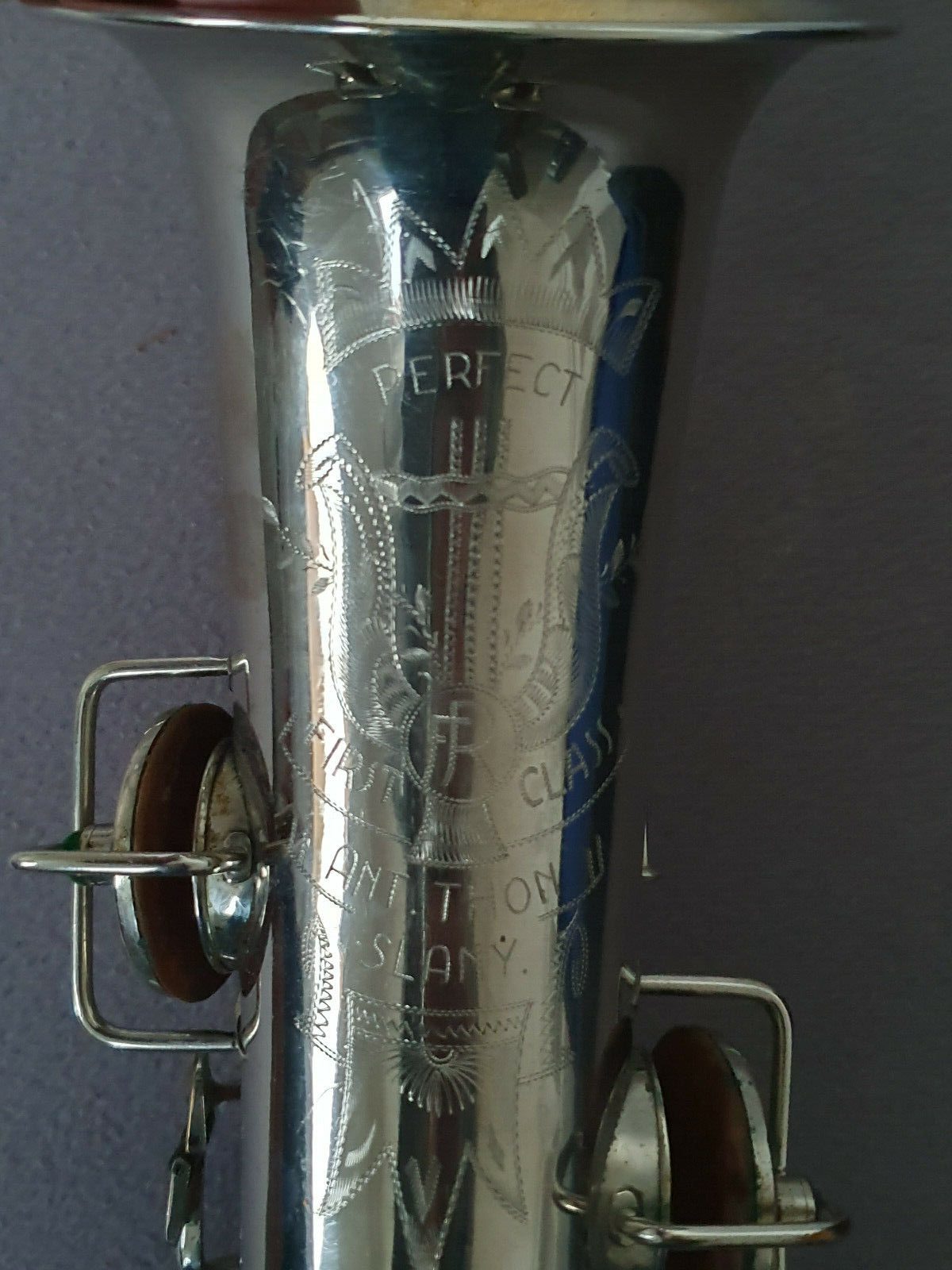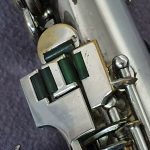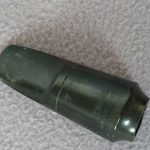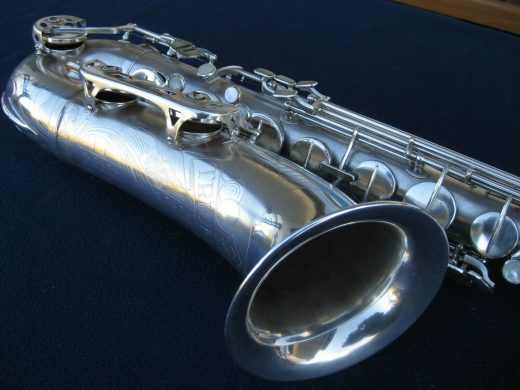Over the past few days, as I was re-tooling both landing pages for this Bassic Sax Blog, and its corresponding Bassic Sax website, I looked at what the most popular topics have been that attracted people to my site over the years. Without a doubt, the top 3 global categories that cause people to visit my site are: bass saxophones, various saxophone-shaped “things”, and of course, vintage saxophones.
So for those of you who like to see vintage saxophones of all stripes, and you armchair, vintage sax researchers, today I have a real headscratcher for you: A vintage German sax that sent me down many hours worth of rabbit holes. In the end I’m still not sure who really made it.
Last weekend on the German eBay site, an alto saxophone popped up with bell engraving that reads: Perfect First Class FR / Ant. Thon Slany.


No amount of Googling, searching in German saxophone forums, or searching in German saxophone books, has turned up any information on a company or person by the name of Ant Thon Slany, Atton Slany, or any combination thereof.
I’m also not sure what that engraving is behind after “THON”. Is it a U? Is it a II? Does it matter at all?
What exactly is a Perfect First Class saxophone?
The seller describes it like this:
Schönes gebrauchtes Alt Saxofon, bezeichnet mit “Perfect First Class FR / Ant. Thon Slany 7824BR” das Mundstück ist offensichtlich original zu dem Instrument dazugehörend. Es ist mit “Consul Fabrication Artistique” bezeichnet. (Bitte beachten Sie das Forum vom Musikinstrumenten Museum Markneukirchen) Das Instrument ist in schöner vintage Erhaltung mit den Zeichen der Zeit. Es muss sicherlich überholt und neu bepolstert werden. Teilweise ist das Instrument etwas abgegriffen. Der Koffer zeigt Gebrauchsspuren.
Helen translate says:
Nice used, alto saxophone, engraved “Perfect First Class FR / Ant. Thon Slany 7824BR”. The mouthpiece is obviously original to the instrument. [Obviously how?] It is stamped “Consul Fabrication Artistique”. (Please note the Forum from the Musikinstrumenten Museum in Markneukirchen.) [Been there. Done that. Found nothing of value. YMMV.] This instrument is in nice vintage condition with the features of the times. It will surely need to be overhauled and repadded. [Part of an overhaul last time I checked.] Parts of the instrument’s finish is worn. The case shows signs of use.
At this point I should note that the seller is known to sell obscure, vintage saxophones from the German-speaking regions of Europe. Sadly, their knowledge of these horns is less than stellar. So began my journey down the rabbit holes…
In Faszination Saxophon: Der Saxophonbau Auf Deatschsprachigem Bebiet, Günter Dullat discusses Perfect First Class saxophones. According to Dullat:
At least some (probably all) of the saxophons sold by [Otto] Riedl under his own name with the trademark PERFECT were bought from Hess Nachf. (q.v.) in Klingenthal.
Example of engraving on the bell:
PERFECT
and beneath it, an elaborate engraving showing a harp and an enweaved monogram R. Beside this are the words
FIRST CLASS 1 …
So a few points:
- The description of the engraving sound familiar? It describes exactly what is on the bell of the eBay horn.
- Perfect First Class was a trademark that belonged to Otto Riedl.
- Herr Dullat mentions Hess Nachf. Does this sound familiar? If you’ve been reading my articles for a few years, you might remember this one about Hess saxophones, and it even shows an Otto Riedl saxophone that was for sale at the time.
- Hess was NOT a manufacturer of saxophones, but rather got them from other German saxophone manufacturers.
- In other words, the saxophone currently for sale on eBay would have started out like this:
- Person or company Y orders saxophones from Riedl.
- Riedel then in turn places an order with Hess with company Y’s named stencilled on the bell.
- Hess then turns around and orders those horns from manufacturer Z.
- Manufacturer Z then produces horns with company Y’s engraved on the bell. (In this case, presumably Ant. Thon Slany.)
- The completed horns are shipped from manufacturer Z to Hess.
- From Hess these horns get sent on to Riedl.
- Then Riedl sends the horns on the original ordering company Y.
If your head is doing this  let’s give you a break, and take a look at some pretty sax pictures.
let’s give you a break, and take a look at some pretty sax pictures.
The photos show a vintage sax in very good condition for its age. It appears to be plated with nickel silver, and has a mishmash of features we see in horns from the German-speaking regions of Europe.
Questions, questions, and even more questions
The photos leave me with a number of questions. Questions like:
- Where is the serial #? It doesn’t appear where we expect it to be.
- What’s going on with the MP? It looks like it had the shank cut off.
- Is this a HP horn?
- Although this horn has a G# trill key, it doesn’t have the C/D triller we see in German horns from this era.
- What clues do we have from it’s features, which could lead us to the manufacturer?
What features make this Perfect First Class vintage alto different?
There are distinguishing features that make this horn stand out as different to my eyes. In no particular order they are:
The left pinkie cluster
 I have poured over hundreds of images of vintage saxophones from Graslitz and surrounding environs, all in an effort to find a pinkie cluster that look like the one on this Perfect First Class alto. Talk about frustrating. Yup, I was ready to do this…
I have poured over hundreds of images of vintage saxophones from Graslitz and surrounding environs, all in an effort to find a pinkie cluster that look like the one on this Perfect First Class alto. Talk about frustrating. Yup, I was ready to do this…
In all the books and online galleries I have looked at, I could find only 1 other saxophone with the same left pinkie cluster.
That pinkie cluster was on a Hammerschmidt tenor saxophone that predated the company’s own saxophone production.2 In other words, it too is a stencil horn, and was ordered from likely the same company that Hess ordered the Perfect First Class alto from.
The man on the moon neck brace
The most common man in the moon neck brace, is the one we often see in Buescher saxophones. However, quite a number of European saxophone companies were using a similarly styled neck brace on their saxophones.
Manufacturers using the man on the moon neck brace included: Max Keilwerth (yes, he even put them on his bari saxes); Bohland & Fuchs; whoever made this Otto Riedl stencil from the Hess article noted earlier; Hammerschmidt (made by the company itself, hence for interest only since they could not have made the horn in question); and the Hammerschmidt stencil that was ordered before the company made their own saxophones; et. al.
Right pinkie keys
The shape of the right pinkie keys are another rather unique feature on this Perfect First Class alto sax. Here again, the tenor stencilled for Hammerschmidt we previously mentioned, appears to have the same key work.
If we look over all the name-brand horns produced in the Graslitz region at the time, the right pinkie keys on this Perfect First Class alto most closely resemble those we see on F.X. Hüller horns from what has been called the 1st Period on fxhuller.com.
Here is the same shape on the right pinkie keys of the most ornate saxophone I have ever seen: a gold plated, World Deluxe alto, which is keyed to high G. Less ornate, but just as recognizable, check out the same right pinkie key mechanism on a F.X. Hüller Standard tenor saxophone. (Both are 1st period saxes.)
Although Hammerschmidt could not have built this saxophone—since they didn’t start making saxophones themselves until 1952—when they did, it is interesting that they chose to use the same shape for their own right pinkie keys.
So who made this Perfect First Class vintage alto?
Well that really is the $64,000 question. Although I can’t offer the correct answer 64K, I would love to have some discussion about this. Perhaps, just perhaps, we could generate a logical answer.
In his book, Faszination Saxophon: Der Saxophonbau Auf Deatschsprachigem Bebiet, Günter Dullat provides us with a beautiful colour photograph3 of an Otto Riedl saxophone, which he IDs as most likely manufactured by F.X. Huller. Only problem is, other than the right pinkie keys, none of the other features line up with the Perfect First Class alto’s unique features shown in this article. (Left pinkie cluster is different, and it is lacking the man on the moon neck brace.)
I cannot say with 100% certainty who made this saxophone, but I am 99% certain that whoever made the Perfect First Class alto, also made this Karl Hammerschmidt & Söhne tenor saxophone.
Let’s make this interesting. I have added a poll to see what you good folks think. If you select Other, please leave a comment with your manufacturer of choice. Thanks!
[poll id=”3″]
To start you on your identification hunt, here is the link to Pete’s & my German & Czech-made vintage saxophone galleries. Beyond that, you’ll have to be a detective. If you find any great leads, please leave those in the comments as well. 😎
1 Faszination Saxophon: Der Saxophonbau Auf Deatschsprachigem Bebiet, by Günter Dullat. pp. 214-215
2 Hammerschmidt made saxophones only once they moved into their (then) West German factory in Burgau. Before the move, it is believed highly unlikely that they made any of their own. Their pre-Burgau saxophones were sold under the names Klingson and Karl Hammerschmidt Watzkenreuth. These instruments sported rolled tone holes, and many (most?) of them came from F.X. Huller.
Saxofone: Ein Kompendium, 5th edition, by Uwe Ladwig. p. 176.
3 Faszination Saxophon: Der Saxophonbau Auf Deatschsprachigem Bebiet, by Günter Dullat. p. 215

















The rest is a mystery, but the mouthpiece with the shank cut off is something that has happened to me with a Conn alto microtuner neck – the mouthpiece I wanted to use just would not push on enough to come up to pitch.
So, as the mouthpiece wasn’t worth a fortune, out came the hacksaw… Solved !
(I’ve had to do that also with a Bb soprano mouthpiece on a C-Soprano. And – heracy – I had to cut a few mm off a cheap flute headjoint once, because a guitarist I really wanted to play with insisted that his sharp tuning couldn’t go any lower… Sigh)
The mouthpiece is indeed a bit rough on the crook side. It also looks like a Hess mouthpiece that has been cut on the last ring.
Hess was not a possible answer.
There are a lot of Max Keilwerth like things visible on the perfect. But serial number and pinkie tables do not support this choice.
So my choice is “other” as there are still unknown German saxophone ateliers such as the producer of the Cafarct saxophone.
As I do not believe in the existence of the Saxonon factory, where they mix different parts of German saxophones and give the resulting instrument a random serial number, I name Ernst Karl Riedl as a possible but unlikely candidate.
Yes, I agree with you on the MK stuff. That’s why I was torn on Max being the producer of the horn. Overall though, his designs elements are pretty consistent. I could see maybe it missing a serial #, but the pinkie tables just don’t fit his designs, while the rest almost all does.
It is interesting how so many horns from the region have bits that all look like they came from the same manufacturer. EG: Why do so many all have the same bell to body support brace?
Oh, and about that support brace, that’s the same one MK used on his Hohner saxophones—until they were redesigned for their last phase. Was MK the company making these bell to body support braces and supplying other manufacturers? Interesting idea.
Hey there Alan. Interesting. You know, I would not have thought of cutting off a MP due to a microtuner, but what you’re saying makes sense.
Funny you should mention a Bb soprano MP on C soprano. When I first got my C soprano, Randy Emerick suggested I try a Yamaha Bb soprano MP on it. (ATT the key heights on the horn were not properly set, and my tech didn’t know exactly what they should be set at, so the tuning wasn’t 100% perfect with the C MPs I had.) Randy noted that these Yamaha pieces work perfectly well on the Conn New Wonder horns like I had.
Fortunately the good folks at Bellingham Windworks had the identical horn in silver that I had played, and that I knew I could play in tune. Their tech sent the key heights to my tech, and David set my horn’s key heights to the same specs as the horn I had played. Suddenly mine played perfectly, with no further MP trials needed. But I have always filed that piece of information away with the idea that I should try it some time.
While there is some wiggle room for CA Wunderlich to have made their own horns at one point, all of these are FX Huller:
https://bassic-sax.info/pix/index.php?/category/13518
https://bassic-sax.info/pix/picture.php?/61250/category/16152
http://fxhuller.com/stencils.php (Magna)
The low C is a distinctive shape. As for the left hand pinky cluster, FX Huller had so many different designs that I don’t have a good argument against saying it’s FX Huller.
I do know we have a couple other horns in the gallery with a neck brace that is either similar or identical.
I agree that F.X. Huller is a likely candidate. Still the shape of the G# key puzzels me.
I have an old German saxophone with a typewriter style G# key. if you ad a roller to such a key you get this type of G# key. It could function as an alternative for a G# low B/C# linking mechanism.
Only when you want to play from G# to low B flat without a glissando B you need a longer roller.
And when you make the key longer it is easier to ad a G# to low B link on that key and forget the roller.
So it looks like a short-lived intermediate construction.